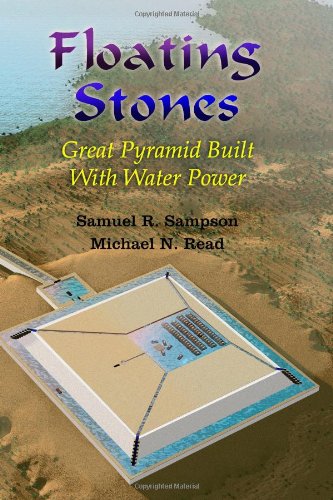
Now here is an interesting find, recommended by a good friend. This book is a very thought-provoking theory of how the Great Pyramid was built.
Authors Samuel R. Sampson is an architect, and co-author Michael N. Read is an engineer. Together they have come up with a very plausible scenario on how the largest Egyptian pyramid was built, using conventional techniques of the time.
These days, with the various “Ancient Alien” TV shows and the like, which assume that because we have trouble figuring out how huge monoliths and stone structures were built, that alien technology or sound waves etc. must have been involved.
We now know that the pyramids were not built as huge crypts, as no ancient royalty were entombed in them. The authors do not consider the exact purpose of these structures. Nor do they examine other huge stone structures found around the world. That’s good enough. We can leave speculation about other sites for others to consider.
In a nutshell, the authors demonstrate, with evidence, that the ancient Egyptians used the (then greater) flow of the Nile River along with a powerful underground aquifer to transport and lift stones into position. They cite the Egyptians technology at the time – hydrology, rock drilling, boat building etc. to complete the build – at least on the Great Pyramid.
In this theory, aqueduct-style canals led from the Nile to the building site. Ancient texts are referred to as to the clearing and leveling of the site, as well as veiled descriptions of the technology used.
A perimeter wall was assembled and, with a system of valves, flow controls and locks, water levels were raised as necessary. Much of the water was supplied by a powerful underground aquifer, the type that supplied various “oases’” in the region. Of course, it was likely a much different environment when these structures were built.
I have to admit, I am not science-minded, but I find the authors provide a very convincing argument for the construction of this huge structure, using simple technology. Additionally, I do not have a firm grasp of ancient societies and technologies. It does indeed make me wonder about other huge structures, stone monoliths, and habitats drilled directly into rock at other sites around the world.
“Floating Stones – Great Pyramid Built With Water” shows us how it would be possible for ancient man, using simple conventional technology – to have built this immense structure.
– No aliens needed.
It is a fairly quick read, even for a layman like me, with lots of pictures, drawings and references. I found it fascinating, and the authors had clearly thought out every stage of construction.
We may never completely understand the purpose of such immense stone structures, but this book goes a long way to explain an entirely conventional building technology. Well worth the quick read.
– John Titus


I know both of the authors. Studious is a word that comes to mind in trying to describe both of them.
The hypothesis set forth in Floating Stones is far more plausible than the old grade-school dogma about 100K Egyptian slaves lugging 10-ton blocks of stone with ropes up an imaginably steep incline, and carefully fitting them together one by one with near laser precision until they reached the top of a 400 ft pyramid.
Then (just for good measure) the structure is clad with cut marble panels (tiles), which are again fitted together with surgical precision, up to 400 feet in the air.
Carson,
Thanks for your comments!
Actually, the casing stones that clad the pyramid were polished limestone blocks from the Tura quarry, upstream and across the Nile River from the Giza Plateau. They floated them on barges across the river and up the Causeway to the pyramid and above the 7th course, transferred them to the water locks at each of the four corners where they were conveyed upward to the level under construction. The pyramid was built over the top of an existing artesian well whose font was provided by the largest aquifer in the world, the Nubian Sandstone Aquifer System. It fed water to the top of the pyramid where it was conducted to the four corners to bring the stones up…the lower stones were huge; but above the 7th course they were smaller and fit inside the Water Stairs, the locks on the corners. The huge monoliths in the internal chambers were brought in when the first course was begun, to a central pool where they floated until incorporated. The pool was elevated with each level change by displacement of the water by placing core blocks in the bottom of the pool which raised the water height. There’s more to it, but that’s the gist of it!